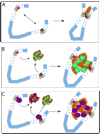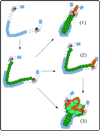Enhancers: the abundance and function of regulatory sequences beyond promoters
- PMID: 20025863
- PMCID: PMC3060611
- DOI: 10.1016/j.ydbio.2009.11.035
Enhancers: the abundance and function of regulatory sequences beyond promoters
Abstract
Transcriptional control in mammals and Drosophila is often mediated by regulatory sequences located far from gene promoters. Different classes of such elements - particularly enhancers, but also locus control regions and insulators - have been defined by specific functional assays, although it is not always clear how these assays relate to the function of these elements within their native loci. Recent advances in genomics suggest, however, that such elements are highly abundant within the genome and may represent the primary mechanism by which cell- and developmental-specific gene expression is accomplished. In this review, we discuss the functional parameters of enhancers as defined by specific assays, along with the frequency with which they occur in the genome. In addition, we examine the available evidence for the mechanism by which such elements communicate or interact with the promoters they regulate.
Copyright 2010 Elsevier Inc. All rights reserved.
Figures


References
-
- Banerji J, Rusconi S, Schaffner W. Expression of a beta-globin gene is enhancer by remote SV40 DNA sequences. Cell. 1981;27:299–308. - PubMed
-
- Bell AC, West AG, Felsenfeld G. The protein CTCF is required for the enhancer blocking activity of vertebrate insulators. Cell. 1999;98:387–396. - PubMed
-
- Bender MA, Bulger M, Close J, Groudine M. Beta-globin gene switching and DNaseI sensitivity of the endogenous beta-globin locus in mice do not require the locus control region. Mol. Cell. 2000;5:387–393. - PubMed
Publication types
MeSH terms
Substances
Grants and funding
LinkOut - more resources
Full Text Sources
Molecular Biology Databases

